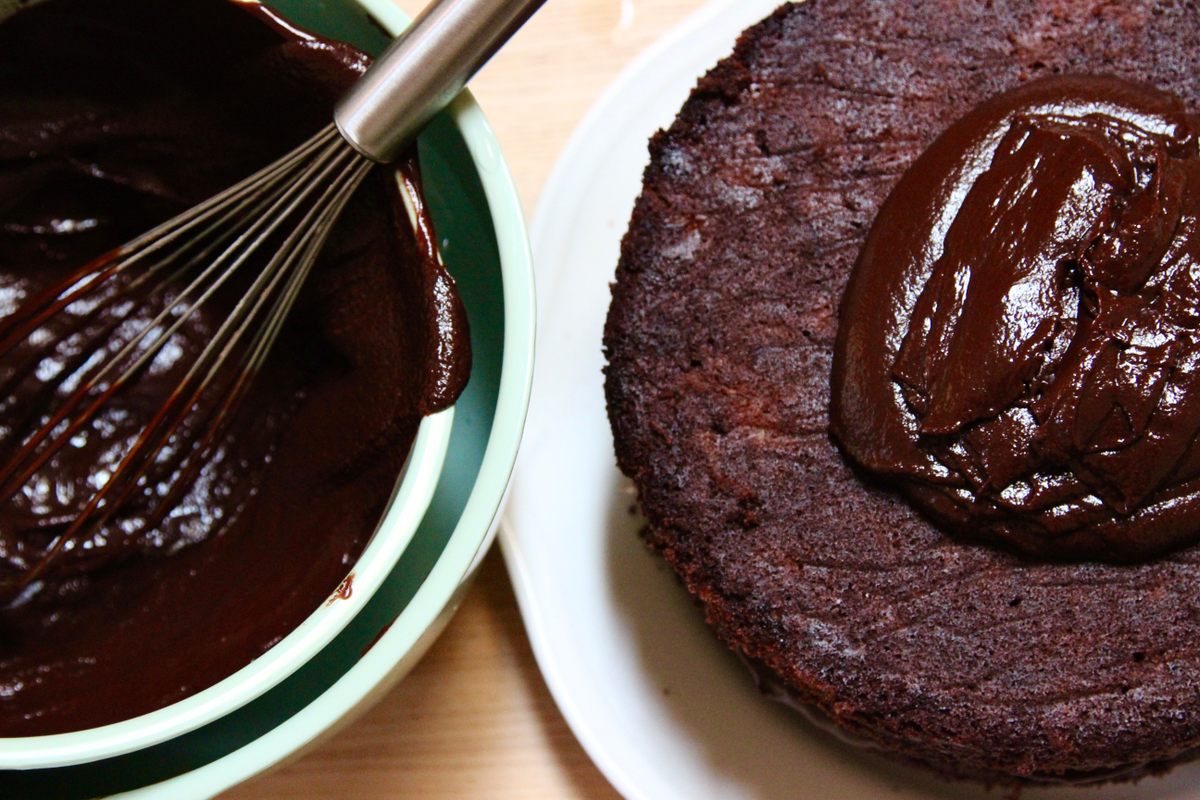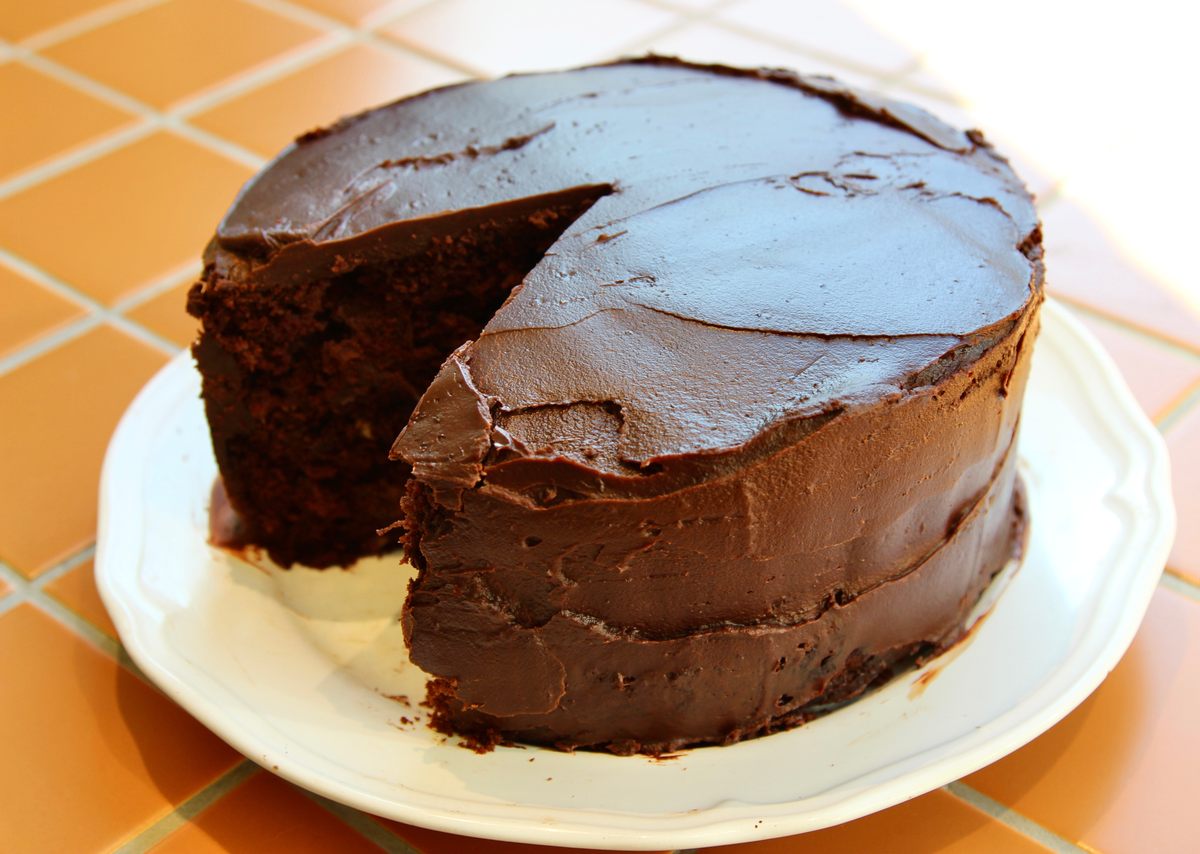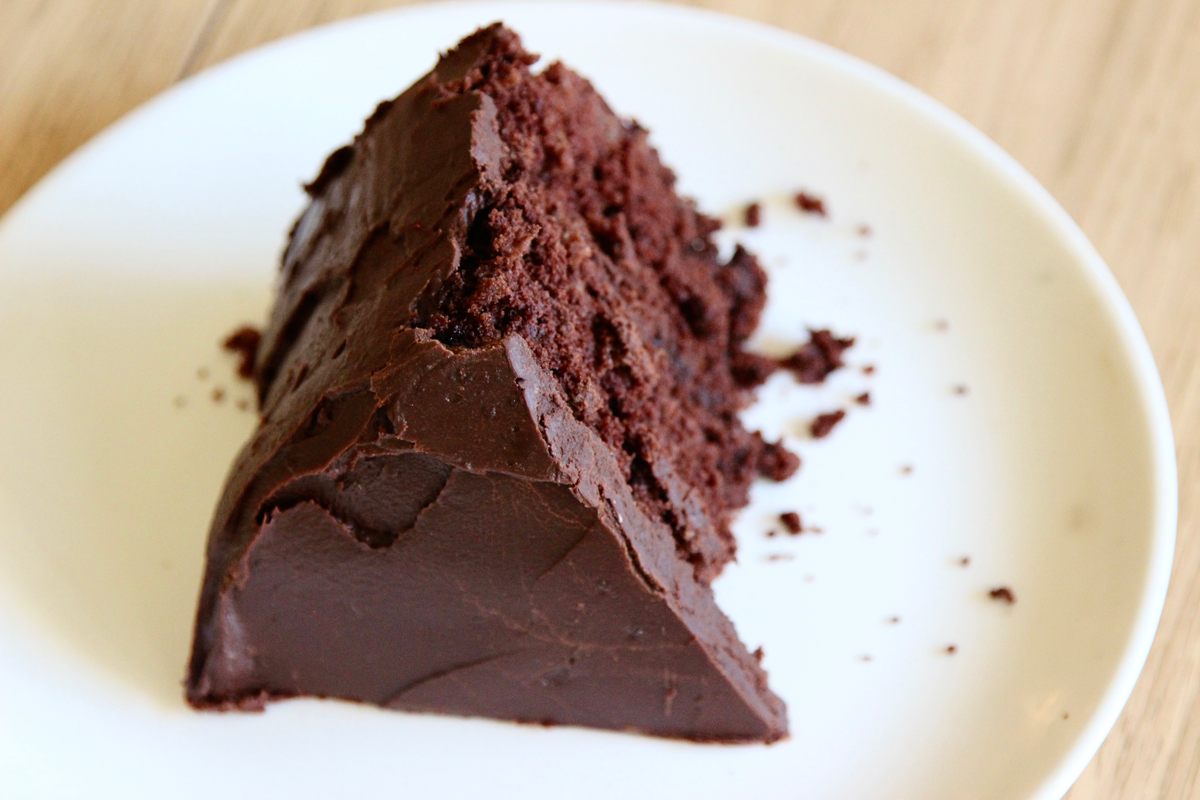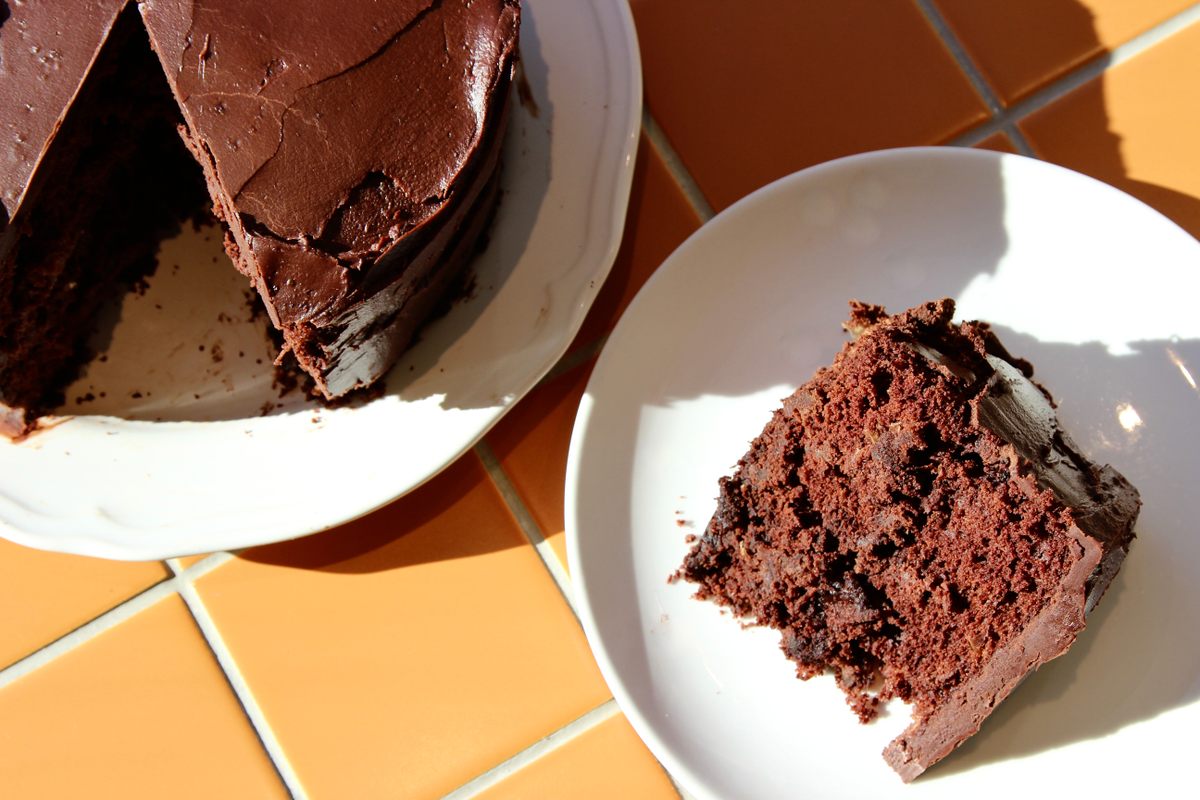On October 21, 1965, the San Bernardino Sun ran a recipe for what it described as a “moist luscious piece of chocolate cake.” The newspaper promised a dinner-party crowd pleaser, yet added conspiratorially, “your guests will not guess your secret until you are ready to reveal it to them.” In this case, the secret was “crisp, crunchy sauerkraut.”
Home bakers have always reveled in a secret ingredient—the weirder the better. When The Washington Post ran a similar recipe years later, it dubbed its chocolate sauerkraut confection “Don’t Ask Cake” because “people who eat it can’t guess what the secret ingredient is—and don’t want to believe it when they find out.” Whether it’s mayonnaise, which first appeared in a chocolate cake recipe in 1927, or vinegar, which makes the eggless, butterless, Depression-era “wacky” chocolate cake rise, or the can of Campbell’s condensed tomato soup in “magic cake,” there is something inherently satisfying about engaging in a little culinary trickery.
According to the San Bernardino Sun, the kraut cake was the invention of a “creative and enterprising cook,” Geraldine Timms, a lunch-lady who worked at Waller High School in Chicago. In 1962, canned sauerkraut was among the surplus foods distributed to lunch programs in the Chicago public school system by the government. School officials tasked lunchroom supervisors with finding ways to get rid of a massive stockpile of pickled cabbage. Timms rose to the challenge spectacularly with a “real winner,” a double-tiered, improbably kraut-filled chocolate cake, topped with mocha whipped cream.

It’s a good story, although as is so often the case with food origin myths, it may or may not be entirely true. In 2003, Bob Channing, a Californian reader of The Baltimore Sun, wrote in to ask for the recipe, writing, “Before my mother passed away, she lent her only copy of this cake recipe to a friend and forgot about it. The cake, I believe, was created during World War II.” When wartime rationing rendered butter, sugar, and flour scarce, home bakers got inventive with transforming vegetables from their victory gardens and cans in their larder for cakes. Perhaps that’s how cabbage got turned into a cake ingredient.
“That’s an interesting theory, but I’ll bet if you went to a library with a big collection of church cookbooks, you would find recipes predating World War II,” says Sandor Katz, the “Fermentation King” behind books including Wild Fermentation and Fermentation Journeys. “The origins of foods are murky,” he says. “We have rough ideas about the geographic places where different cultivated plants emerged. But most food traditions, people just don’t know.”
As an example, he points to sauerkraut itself. Most publications claim that nomadic Central Asian people carried fermented cabbage with them to Europe from China. “I have never seen a citation. I’ve never seen a footnote,” Katz says.

There’s an element of plausibility there. Suancai, a form of pickled cabbage in China, has been around for centuries, if not millennia, but it’s impossible to prove that no one else came up with the idea on their own. “I think sometimes in history, stories just get repeated,” Katz says. “That’s not to say it’s not true, but I’d be a little skeptical that that’s the whole story.”
Much like chocolate sauerkraut cake, Katz believes sauerkraut itself was most likely born out of pragmatism. “Once people invest themselves in a sedentary agricultural lifestyle in a temperate climate, people need strategies for surviving the winter,” he says. Preserving cabbage, a plentiful vegetable filled with nutrients, would be a no-brainer. “It wouldn’t surprise me if people in different parts of Europe sort of figured out sauerkraut independent of that story.”
There is some credibility to the idea that Mrs. Timms the lunch lady independently came up with the idea to plunk sauerkraut into chocolate cake. Ever since the creation of the Federal Surplus Commodities Corporation during the 1930s, school lunch programs have often been used as a way to unload excess stockpiles of commodity foods. But she probably wasn’t the first one to do it.
“The idea of using vegetables in a cake to moisten it, to make it more nourishing, that’s not exactly alien,” Katz says. “We already had carrot cakes, we had zucchini cakes.” Carrots alone show up in 19th-century bourgeoisie French cookbooks, and they appeared in European desserts as early as the Middle Ages.

Prior to the invention of baking powder in 1856, home cooks relied on acidity to lift their cakes, often in addition to an alkaline leavener. “The idea of using a sour product of fermentation to aid in the rising of a cake isn’t so strange,” Katz says.
Recipes for chocolate sauerkraut cake crop up everywhere from a 1973 edition of Recipes from the Tower Kitchen from Detroit to a 1981 edition of The New York Times for “Sauerkraut Kuchen,” which identifies it as coming from German immigrants in Texas. (German blogs and magazines, meanwhile, regularly refer to American chocolate sauerkraut cake with incredulous descriptions such as “for anyone who is brave and wants to try something new.”)
Regardless of whether it was invented in response to wartime rationing or meager school lunch budgets, “Don’t Ask Cake” has all the hallmarks of one of those great ideas that was born out of necessity. For the most part, these inventions in baking fall by the wayside in more prosperous times. Virtually no modern restaurants bother with “slugburgers”—a Depression-era recipe for patties that stretched limited ground beef supplies with potato starch—or “victory cakes” sweetened with boiled raisins due to wartime sugar rationing.
Yet sauerkraut cakes have survived through the generations because they work, particularly when rendered more luxurious with the addition of copious amounts of chocolate. Fermented foods inherently add depth of flavor, and the acidity from the vinegar used to pickle the sauerkraut limits gluten development, resulting in a tender-crumbed cake with a mild tang that stays moist for days. And just like school children in the 1960s, no one will ever guess how you did it.

Chocolate Sauerkraut Cake
Adapted with permission from Sandor Katz.
- 12 to 16 servings
Ingredients
- 12 tablespoons butter at room temperature
- 1 ½ cups granulated sugar
- 3 large eggs
- 1 teaspoon vanilla extract
- 2 ¼ cups all-purpose flour
- 1 teaspoon baking soda
- 1 teaspoon baking powder
- ½ teaspoon salt
- ½ cup Dutch process cocoa powder
- 1 cup hot, strong coffee
- 1 cup sauerkraut, rinsed, drained, squeezed of excess moisture, and chopped fine if necessary
- 1 pound bittersweet chocolate, finely chopped
- 1 cup heavy cream
- 2 tablespoons granulated sugar
- 2 tablespoons light corn syrup
- 4 tablespoons butter, cut into pieces
- Pinch of salt
Instructions
-
Preheat the oven to 350° F. Lightly grease and flour two round 8-inch cake pans.
-
Combine all-purpose flour, salt, baking soda, and baking powder in a medium bowl. Set aside.
-
Mix the hot coffee with cocoa powder in a liquid measuring cup or bowl to bloom the cocoa. Stir until fully combined and set aside.
-
Using a standing or handheld mixer, cream butter and sugar until light and fluffy. Beat in eggs one at a time, making sure each is fully incorporated before adding the next. Add in vanilla extract.
-
Beat the dry ingredients into the butter, sugar, and eggs in three additions. When no streaks of flour remain, gradually add in the coffee and cocoa and mix until thoroughly combined.
-
Fold in drained sauerkraut and mix until combined.
-
Evenly distribute cake batter between the two prepared pans, then bake for 30 to 35 minutes or until a toothpick inserted into the center of the cakes comes out mostly clean. Remove cakes from the oven and let them cool completely on a wire rack.
-
When the cakes are cool, make the ganache. Start by heating heavy cream, granulated sugar, and corn syrup in a pan over medium-low heat, whisking until the granulated sugar is fully dissolved and the cream is beginning to simmer.
-
Gradually add the finely chopped chocolate to the cream mixture, whisking after each addition until the chocolate is fully melted. After all of the chocolate is incorporated, whisk in the butter one tablespoon at a time, then add a pinch of salt to taste.
-
Transfer ganache to a bowl set over ice water and keep whisking until the mixture is cool enough to spread, but not fully set.
- Using a knife, carefully remove cake layers and invert onto plates. Frost the layers and serve.
Gastro Obscura covers the world’s most wondrous food and drink.
Sign up for our email, delivered twice a week.
Bagikan Berita Ini














0 Response to "Who Decided to Put Sauerkraut in Chocolate Cake? - Atlas Obscura"
Post a Comment